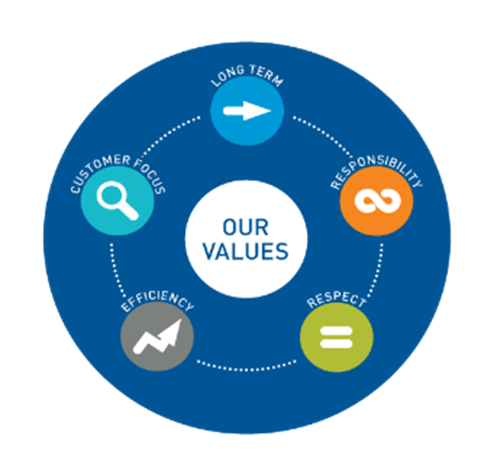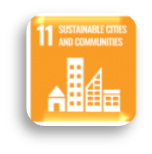
Vision |
 To set unified corporate goals for the group of Companies, the Company has clearly laid out the organization’s written Vision, Mission, and Core Value. Vision defines the aims and ultimate goals of the organization so that all parties adhere to the business operation as a common principle. To set unified corporate goals for the group of Companies, the Company has clearly laid out the organization’s written Vision, Mission, and Core Value. Vision defines the aims and ultimate goals of the organization so that all parties adhere to the business operation as a common principle.
“To be “a leading lime manufacturer and minerals processor in South-East Asia”” in delivering highest values to all Shareholders and Stakeholders. “We contribute to a better world” is established and aligned with our vision. |
Objective |
The business objective of the company and its subsidiaries is to produce and distribute the following main products:
|
The company's direction and mission have been formulated to correspond with the vision and core values set forth by Carmeuse,
the principal indirect shareholder. Our objective is to deliver care and services to our customers and stakeholders.
These values have been instilled in all employees to foster a professional work ethic and mindset. The framework is outlined as follows:
 |
Goal |
Economic and Governance
Social
Environmental
|
Business Strategies |
| The company has developed business strategies to drive the organization meet its objectives within the designated timeline. The strategic framework consists of three tiers: Corporate strategy, Business strategy, and Operational strategy. |
Corporate strategy |
| “The three paths to business sustainability of SUTHA”, which the Sustainable Development Committee proposed to the Board of Directors for approval as a strategy for driving and developing sustainability, consisting of 3 aspects: environment (E), society (S) and economy and governance (G) that set goals in the short, medium and long term. |
 |
| Aligned to | Short Termed Goals, 1 – 2 yrs. |
|---|---|

|
Environmental (E)
SDG13, SDG 6 , SDG 7, SDG 11 |
 |
Society (S)
SDG 3, SDG 6, SDG 4, SDG 8, SDG 16 |
 |
Economic and Governance
SDG 7, SDG 9, SDG 12, SDG 15, SDG 16, SDG 17 |
| Support to | Short Termed Goals, 3 – 5 yrs. |
|---|---|

|
Environmental (E)
SDG 13, SDG 6 , SDG 7, SDG 11 |
 |
Society (S)
SDG 3, SDG4, SDG 6, SDG8, SDG 16 , SDG 17 |
 |
Economic and Governance
SDG 12, SDG 9, SDG 7, SDG 15, SDG 16, SDG 17 |
| Support to | Short Termed Goals, 3 – 5 yrs. |
|---|---|

|
Environmental (E)
SDG 13, SDG 6 , SDG 7, SDG 11 |
 |
Society (S)
SDG 3, SDG 4, SDG 6, SDG 8, SDG 16, SDG 17 |
 |
Economic and Governance
SDG12, SDG9, SDG7, SDG15, SDG16, SDG 17 |
Such 3 paths link to the SDG’s goal of sustainability development.
 All internal Stakeholders get involved to drive sustainability business development through routine business activities in response to the United Nations Sustainable Development Goals SDG's Goal.
All internal Stakeholders get involved to drive sustainability business development through routine business activities in response to the United Nations Sustainable Development Goals SDG's Goal.
SUTHA has also adopted and adjusted the Carmeuse strategic policy incorporated with the corporate governance of listed companies to support SDG’s Goal. (GRI: 3-3)

|
SDG’s 2 To end hunger, achieve food security, improve nutrition, and promote sustainable agriculture. Lime and Calcium carbonate application in sugar production, animal feed, fishing, and agricultural industries, solutions to soil acidity and water treatment > Educate to expand businesses to the agricultural sector. > Promote the use of lime to improve soil condition. > Develop business partners for product distribution across all regions |
|---|---|
 |
SDG’s 3 Ensure health and well-being for all andPrioritize the health and welfare of our employees, their families, and the surrounding local communities. The core strategy of the Company > Achieve a zero-accident workplace and > Promote better health of employees and their families. > Engage with local authorities to develop the quality of life or health of the communities around the business. |
 |
SDG’s 4 Ensure equitable quality education and promote lifelong learning opportunities for all We implement > Personnel development > Succession plan > Knowledge improvement program for both personnel and customers to improve their potential > Learning opportunities of new technologies and > Partnering with targeted schools for future personnel and > Exchange as a Learning Share method. |
 |
SDG’s 6 “Clean water” is essential for life. SUTHA products play a vital role in the treatment of both drinking and wastewater to soften water, neutralize pH, and remove organic impurities and heavy metals. The Company’s strategy > to develop water treatment solutions as new product development, acquisitions, and > expanding operations in new regions, along with supporting wildlife conservation activities and promoting the usage of environmentally friendly products among business peers |
 |
SDG’s 7 Ensure access to affordable, reliable, sustainable and modern energy for all We are committed to > Clean and renewable energy consumption and > Energy optimization Our products play a key role in the production of Solar Glass and the elements of windmills. Additionally, with support from the Carmeuse group, we initiated in > alternative fuels > reducing energy consumption > investing in renewable energy > efficiency improvements of our customers and partnerships aiming at turning our unavoidable process CO2 emissions into a resource for renewable energy. |
 |
SDG’s 8 Promote inclusive and sustainable economic growth > full employment > productive employment and > decent work for all. The core of our sustainability strategy is > Prosperity means we establish priorities to sustain long-term profitable growth, which in turn > provides jobs in our communities, many of which in rural areas, along with opportunities for employee development. > To support this strategy, we continue to expand and diversify our business through acquisitions and work to develop innovative solutions for future challenges. |
 |
SDG’s Target 9 Build resilient infrastructure, promote sustainable industrialization and foster innovation. Our primary business starts with lime and limestone, which have been used in infrastructure projects for thousands of years. Currently, our largest growth segment is in construction, thus making it a key part of our strategic focus. Our strategy focuses in three areas: > mergers & acquisitions, > innovative solutions and expansion of offerings to broaden our portfolio, develop solutions to replace environmental impact of products and > expand our footprint to support infrastructure projects. |
 |
SDG’s Target 10 Mitigate social disparities by fostering local employment opportunities, ensuring that compensation is at least equal to the legally mandated minimum wage. Strategic goal > Promote local employment > Provide equal opportunities in employment without gender discrimination. > Do not pay wages below the minimum legal wages |
 |
SDG’s Target 11 Making cities safe and sustainable Strategic Goals: > Promoting safety of the workplace, customers, communities and stakeholders > Employees follow safety measures in both the company's workplace and those of customers, communities, society, and stakeholders. > Arrange safe environment and protective equipment to ensure safety in every establishment and every process |
 |
SDG’s Target 12 Ensure sustainable consumption and production patterns > It all starts with our quarry management in the most efficient way, and ends with developing innovative uses for all variations of our materials with focus on > acquisitions, product development and > operation improvements > reuse, or > minimize landfilled materials. |
 |
SDG’s Target 13 Take urgent action for climate change and its impacts. Carmeuse Group overarching strategy for > reaching CO2 neutral by 2050, provided that the global team in place focuses on the following five pillars: 1) Energy Efficiency, 2) Alternative Fuels, 3) Asset Base Transformation, 4) Circular Model and 5) CO2Neutral Footprint SUTHA also drives these five pillars in promoting other businesses to reduce its impact on climate change. Additionally, the Application teams are setup to work with our customers to improve processes and efficiencies which reduce CO2 impacts. |
 |
SDG’s Target 15 Protect, restore and promote sustainable use of terrestrial ecosystems > Planting more trees > Sustainably manage forests and > Halt biodiversity loss Land is considered a factor of business, then it is the responsibility of the business to > Recover an ecosystem to reflect its intrinsic values > Restore and enhance biodiversity throughout the life cycle in the quarry management process > improving water quality > Planting more trees > Promote biodiversity through various cooperation to ensure that the ecosystems, communities, and land associated with the business are properly restored. |
 |
SDG’s Target 16 Promote peaceful and inclusive societies for sustainable development, provide access to justice for all and build effective, accountable, and inclusive institutions at all levels. 1) Implement good corporate governance throughout SUTHA business operations 2) Develop internal controls and risk management throughout SUTHA business operations 3) Develop corporate contingency, emergency plan 4) Develop a mitigation plan for business continuity 5) Involve international standards and practices into business operations |
 |
SDG’s Target 17 Strengthen the means of implementation and revitalize the global partnership for sustainable development. Strategic goals in 3 aspects; 1) Sustainable value chain management 2) Sustainability policy framework and sustainability goals engagement 3) Sustainability policy framework and sustainability goals stakeholder inclusion |
Operational Strategies adhering to “Operational Excellence”
 • Safe Process, Personal Safety and Environment Compliance with the Occupational Safety and Health standards ; implementing safe working procedures throughout the production process and managing environmental practices within the organization, thereby ensuring the highest performance standards in alignment with the organization's safety protocols.
• Safe Process, Personal Safety and Environment Compliance with the Occupational Safety and Health standards ; implementing safe working procedures throughout the production process and managing environmental practices within the organization, thereby ensuring the highest performance standards in alignment with the organization's safety protocols.
• Quality Excellence Emphasizing manufacturing high-quality products. The ongoing marketing efforts address a variety of market demands to maintain a competitive edge sustainably, while exclusively providing the highest quality offerings.
• Energy Mitigating environmental impact through efficient energy utilization, investing in solar energy, renewable energy, and low-carbon energy initiatives. Additionally, effective management of energy resources is essential to maintain stability and ensure uninterrupted production processes.
• Project Development and Execution Formulate investment initiatives aimed at enhancing processes, ensuring operational continuity, and generating opportunities for business expansion by effectively managing risks and protecting investments until the projects are systematically completed under stringent oversight.
• Yield and Supply Chain Emphasizing the production processes to enhance manufacturing efficiency in order to achieve a competitive edge.
• Reliability Prioritizing the maintenance of machinery for enhancing production efficiency to satisfy market demands.
• Cost Effectiveness Efficiently controlling and managing costs through the utilization of various tools, including Statistical Process Control (SPC) and Lean Manufacturing, aims to enhance the value of products and services while striving for the optimal use of resources.
• Operation to ensure business and operation sustainability by implementing innovative management tools and techniques, which include:
- 1) Strategy - defining consistent paths and goals
- 2) Culture - Encouraging employees to work together to create new ideas and implement innovations that enhance work, processes, or products.
- 3) Process– capable of measuring, replicating, and achieving success.
- 4) Tool & Techniques - employed to encourage innovation.
- 5) Matrices – Performance metrics to evaluate effectiveness with measurable capacity.





